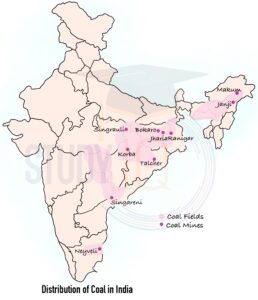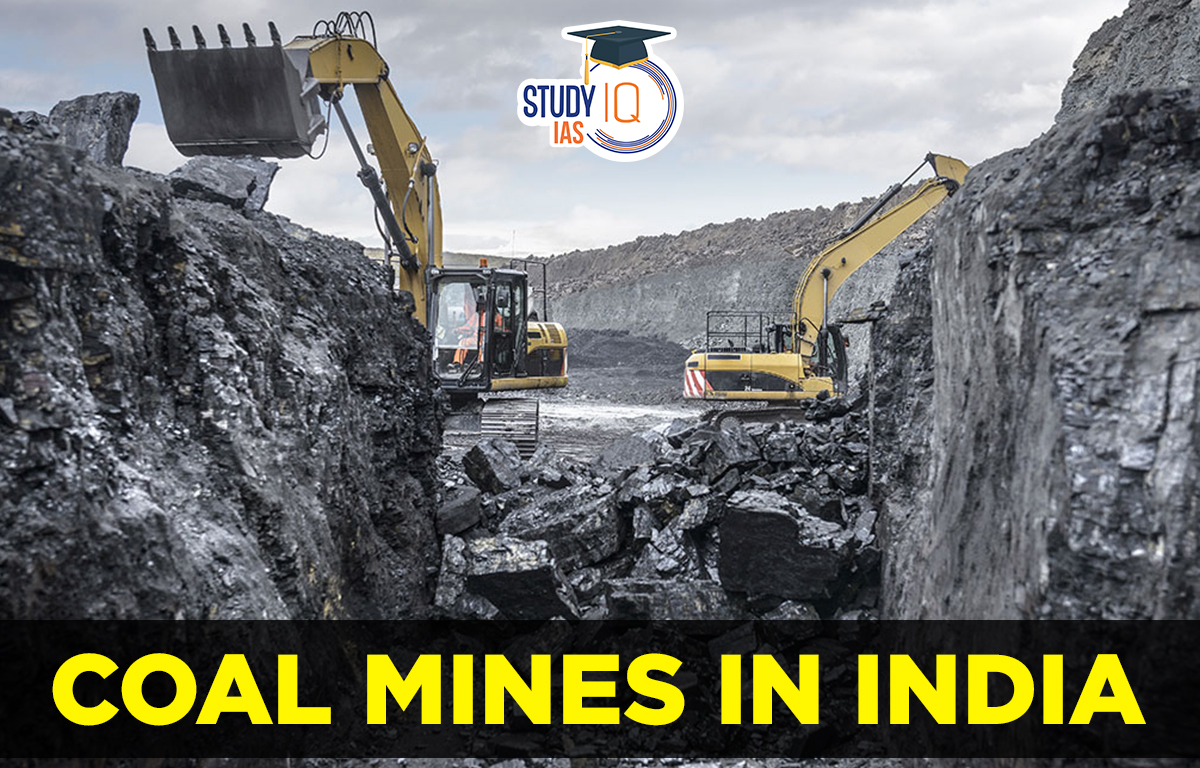Table of Contents
Coal Mines in India
India has around 319 billion tonnes of coal reserves and is one of the largest coal-producing countries in the world. The major coalfields in India are located in the eastern and central regions of the country, and the coal found in India is primarily bituminous and sub-bituminous in nature.
India has two major types of coal reserves – Gondwana coal and Tertiary coal. One of the most significant and ancient coal reserves worldwide is the Gondwana coal, found in central India, while the Tertiary coal, which is relatively younger, is predominantly found in the northeastern region of India. Both types of coal are used for power generation and other industrial purposes. Gondwana coal is further classified into three categories based on its carbon content – anthracite, bituminous, and sub-bituminous.
List of Coal Mines in India
Here is state wise List of Coal Mines in India.
| State | Name of Coal Mines |
| Jharkhand | Jharia Coalfield |
| Giridih Coalfield | |
| Bokaro Coalfield | |
| North Karanpura Coalfield | |
| South Karanpura Coalfield | |
| Ramgarh Coalfield | |
| Daltonganj Coalfield | |
| Odisha | Talcher Coalfield |
| Ib Valley Coalfield | |
| Jharsuguda Coalfield | |
| Rampia Coalfield | |
| Mand-Raigarh Coalfield | |
| Chhattisgarh | Korba Coalfield |
| Hasdeo Arand Coalfield | |
| Mand-Raigarh Coalfield | |
| West Bengal | Raniganj Coalfield |
| Madhya Pradesh: | |
| Singrauli Coalfield | |
| Pench-Kanhan Coalfield | |
| Satpura Coalfield | |
| Telangana | Singareni Collieries Company Limited |
| Tamil Nadu | Neyveli Lignite Corporation |
| Maharashtra | Wardha Valley Coalfield |
| Pench-Kanhan Coalfield | |
| Assam | Makum Coalfield |
| Ledo Coalfield | |
| Lakhimpur Coalfield | |
| Borholla Coalfield | |
| Namdang Coalfield | |
| Meghalaya | Jaintia Hills Coalfield |
| Garo Hills Coalfield | |
| Nagaland | Tiru Valley Coalfield |
| Chumukedima Coalfield | |
| Arunachal Pradesh | Namchik-Namphuk Coalfield |
Read about: Hydropower Plants in India
Types of Coal
The various types of coal found in India include:
| Type of Coal | Description |
| Anthracite | It is the highest quality and rarest form of coal found in India. It has a high carbon content, low ash content, and high heating value. |
| Bituminous | It is the most commonly found coal in India and accounts for more than 50% of India’s coal reserves. It has a moderate carbon content and is used for power generation, steel production, and other industrial purposes. |
| Lignite | It is a low-grade coal with a high moisture content and low heating value. It is primarily used for power generation. |
| Sub-bituminous | It has a lower carbon content than bituminous coal and a higher heating value than lignite. It is used for power generation and industrial purposes. |
Read about: Nuclear Power Plants in India
Largest Coal Mines in India
The largest coal mine in India in terms of reserves and production is the Jharia Coalfield located in the state of Jharkhand. Jharia Coalfield is estimated to have a reserve of around 19.4 billion tonnes of coal and accounts for over 60% of India’s total coal production. The coal in this field is primarily bituminous in nature and is used for various purposes, including power generation, steel production, and cement manufacturing. However, due to unscientific mining practices, underground fires have been burning in the Jharia coalfield for decades, which has caused significant environmental and health issues for the local population.
Read about: Major Ports in India
Coal Mines in India Map
A map of coal mines in India provides a visual representation of the location and distribution of coal reserves in the country. Take a look here.

Read about: Land Reforms in India
Coal Mines in India Challenges
Coal Mining in India is faced with several challenges, including:
- Environmental degradation: Coal mining has a significant impact on the environment, including air, water, and soil pollution. Mining activities can cause deforestation, soil erosion, land subsidence, and the destruction of wildlife habitats.
- Health hazards: Coal mining is associated with several health hazards, including respiratory diseases, skin diseases, hearing loss, and accidents. The workers are exposed to coal dust, which can cause black lung disease and other respiratory illnesses.
- Safety concerns: Coal mining is a hazardous occupation, and safety measures are often inadequate. Accidents in coal mines are common, and they can result in loss of life and property.
- Land acquisition and displacement: Coal mining requires a large amount of land, and the acquisition of land often leads to the displacement of local communities. Displaced people often lose their livelihoods and face social and economic hardships.
- Illegal mining: Illegal mining is a major challenge in India, and it leads to a loss of revenue for the government. Illegal miners often use unscientific mining practices, leading to environmental degradation and safety hazards.
- Technological obsolescence: The technology used in coal mining in India is outdated, and there is a need to modernize the mining methods to increase productivity, and efficiency and reduce environmental impact.
Read about: Natural Vegetation in India
Coal Mines in India UPSC
Coal Mines in India are an important topic for the UPSC examination because it is a crucial component of India’s energy sector and has significant implications for the country’s economic growth and development. UPSC aspirants are expected to have a good understanding of India’s energy sector, its challenges, and the various policies and programs aimed at addressing them. In addition, coal mining in India is associated with several social, environmental, and economic issues, and the UPSC exam often includes questions related to these challenges.
Read about: Earthquakes in India


 AI Maker Labs: A Promise to build AI in ...
AI Maker Labs: A Promise to build AI in ...
 Daily Quiz 15 April 2025
Daily Quiz 15 April 2025
 How RBI Responded To Global Trade War Ch...
How RBI Responded To Global Trade War Ch...





















